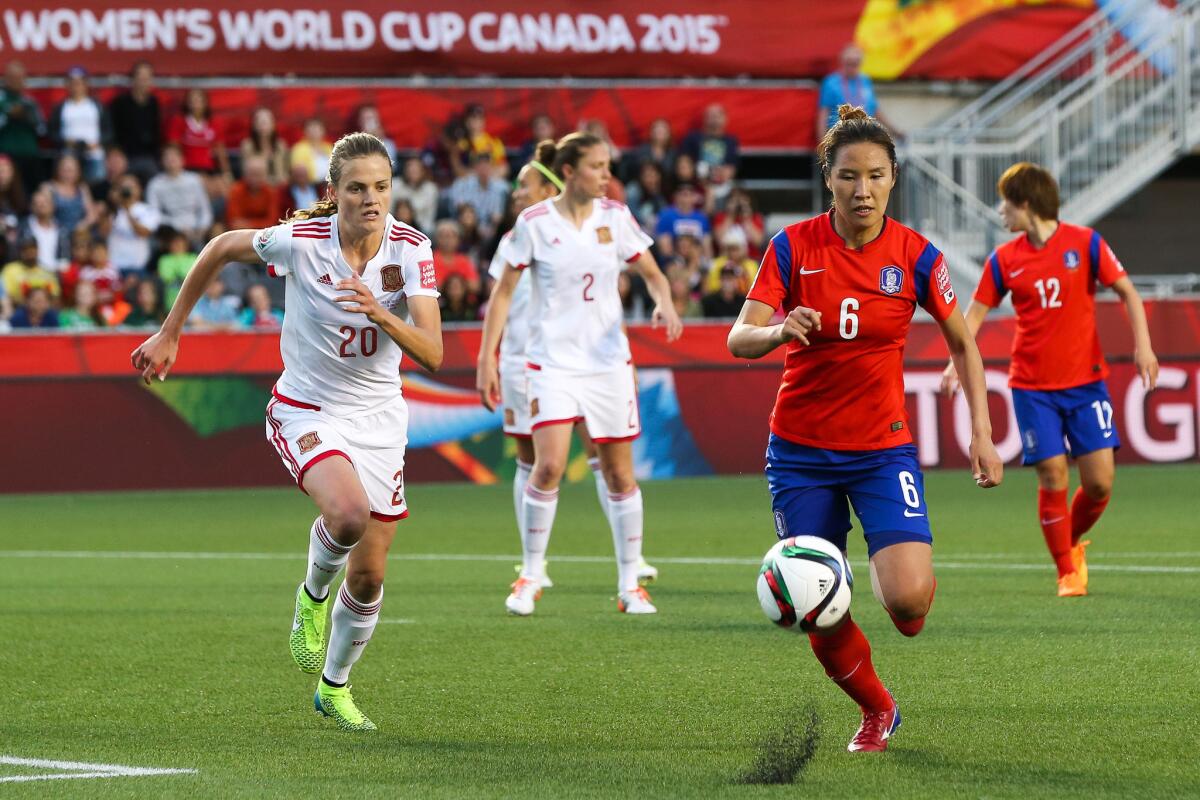Op-Ed: Women’s soccer doesn’t need Sepp Blatter

The South Korean and Spanish soccer teams face off in a FIFA Women’s World Cup game in Ottawa, Canada, on June 17.
- Share via
Why isn’t Sepp Blatter in Canada?
Blatter, the FIFA president who said he would step down in the wake of a corruption scandal, likes to take credit for the global growth of women’s soccer over the last two decades. In an interview with the BBC, he even described himself as the “godfather” of the sport.
But he has yet to appear for a single game of the women’s World Cup in Canada. Indeed, he has not even dispatched his chief lieutenant, FIFA General Secretary Jerome Valcke, to attend. By contrast, both Valcke and Blatter were in Brazil for the entirety of the 2014 men’s World Cup.
Despite his “godfather” claims, Blatter has nothing to do with the surging popularity of the women’s game. True, he once urged the players to wear tighter shorts — a ploy to grab the attention of a potential male audience — but they wisely ignored his advice.
Blatter’s absence reflects FIFA’s not-so-benign neglect of the women’s World Cup.
FIFA’s latest annual financial report touts the $5.7 billion it brought in during the 2011-14 quadrennium. Although the 2011 women’s World Cup in Germany contributed significantly to this sum, you wouldn’t know it from reading the report; it sounds like every last penny came from the men’s 2014 World Cup in Brazil.
Given that FIFA does not explicitly recognize the women’s World Cup’s financial contribution to its coffers, it is not surprising that the women get the short end of FIFA’s prize money. According to the BBC, the total prize money offered to the men’s teams in the 2014 World Cup was $576 million; the total that will be offered to the women’s teams in 2015 is $15 million. Do the math: The men’s prize money is 38.4 times larger than the women’s.
For more evidence of unequal treatment, look no further than the ground on which the players compete. The men’s World Cup is played on grass. But for the women’s World Cup, FIFA said Canadian venues could use artificial turf. The women protested, to no avail.
FIFA even succeeded in creating some bad publicity for the women’s games by manipulating attendance figures. Each of the contests during the group stage in Canada took place as part of a doubleheader. FIFA counted the number of tickets sold to each doubleheader twice, artificially inflating the true figure.
Nevertheless, the Canadian Soccer Assn. has experienced very strong demand for tickets and expects to sell close to 1.5 million seats before the competition ends.
Anyone who doubts the appeal of women’s soccer needs to know that it was the women’s World Cup final between the United States and China in 1999 that reaped the highest U.S. TV ratings of any soccer match ever, attracting 11.4% of U.S. television households. In a distant second was the men’s 2014 World Cup match between the United States and Belgium at 9.8%.
Perhaps Blatter would like to take credit for the 1999 ratings record, even though he became FIFA’s president just a year earlier. More properly, the credit should go to Title IX — the federal law that prohibits discrimination on the basis of sex in any federally funded education program — to charismatic players such as Mia Hamm and Julie Foudy, and to soccer’s escalating popularity among young athletes in this country.
There is, at least, one hero of the women’s game within FIFA: Sunil Gulati, the president of U.S. Soccer. After the failure of two women’s professional soccer leagues, first by poor design and second by the great recession and a weak financial model, Gulati committed millions of dollars from U.S. Soccer to found the National Women’s Soccer League in 2013. U.S. Soccer has spent over $10 million so far in supporting the league.
U.S. Soccer covers the league’s front office expenses, its television costs and the salaries of all the national team players. It is now running two marketing campaigns to promote the women’s World Cup.
Women’s soccer, internationally and in the United States, does not need Sepp Blatter. It needs leaders like Gulati and the positive attention from the media that it richly deserves.
Andrew Zimbalist is the Robert A. Woods Professor of Economics at Smith College and author of “Circus Maximus: The Economic Gamble Behind Hosting the Olympics and the World Cup.”
Follow the Opinion section on Twitter @latimesopinion and Facebook
More to Read
A cure for the common opinion
Get thought-provoking perspectives with our weekly newsletter.
You may occasionally receive promotional content from the Los Angeles Times.






